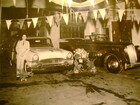|
Re: How were postwar woodies and convertibles made?
|
||||
|---|---|---|---|---|
|
Forum Ambassador

|
Pat, from your questions it sounds like you'd enjoy reading Bob Neal's book on the 48-50 Packards - it goes into considerable discussion on the Station Sedans. I don't think there is data available to say whether they were profitable on a stand-alone basis but certainly they would have done better IMO if they were in the Super Eight lineup.
Posted on: 2013/12/16 23:58
|
|||
|
||||
|
Re: How were postwar woodies and convertibles made?
|
||||
|---|---|---|---|---|
|
Home away from home

|
A general query...there WERE "all-steel" station wagon-esque vehicles being manufactured during the 30's and 40's (e.g. the GMC Suburban). Why didn't that type of body get used on passenger-car based wagons?
Nothing against woodies here...they're beautiful!
Posted on: 2013/12/17 10:36
|
|||
|
||||
|
Re: How were postwar woodies and convertibles made?
|
||||
|---|---|---|---|---|
|
Forum Ambassador
|
One thing about the post war woodies, steel was in short supply after the war, and the wood bodied cars, apart from costing a lot more to the consumer (not sure how the profit margin was on those vs all steel bodies) freed up steel stock to get a few more cars out of the door. They were all sold anyway!
Posted on: 2013/12/17 12:07
|
|||
|
||||
|
Re: How were postwar woodies and convertibles made?
|
||||
|---|---|---|---|---|
|
Home away from home

|
In those days the most expensive models in any car maker's lineup were the convertible and station wagon.
The convertible had an air of youth and fun, the station wagon was associated with the upper crust, the horsey set or the yachting set. I always admired Packard's Station Sedan. If you look closely it uses the maximum amount of standard sedan parts. Doors, rear fenders etc. The rear body structure was made of wood, more or less made and assembled by hand. This means, the tooling cost was minimal. They may have used a modified sedan roof, covered with a vinyl top material. I'm sure they did good business with the Station Sedan. Since it sold for a premium price and tooling cost was small. It gave the dealers something special to sell and added prestige to the line. What they call today a halo model. The convertible must have been more costly to tool. It too sold for a premium price. Whether they recouped the cost on the small number of units sold or whether they considered it an important model to put before the public regardless of cost, I wouldn't know. It is rather surprising that they had a convertible model from 1951 - 56 but never made a station wagon, when the station wagon was one of the hottest selling, and most fashionable cars of the fifties.
Posted on: 2013/12/17 21:16
|
|||
|
||||
|
Re: How were postwar woodies and convertibles made?
|
||||
|---|---|---|---|---|
|
Home away from home

|
Quote:
Station wagon bodies date back to the twenties and were traditionally made of wood. GMC bucked this trend in 1936 by making a "station wagon" by putting windows and seats in a panel truck. It drew little attention and set no sales records. The first all steel wagon designed as such was the 1947 Jeep, which aped the look of the woody. The first sedan based all steel wagon was the 1949 Plymouth. These cars seemed to start a trend followed by Chevrolet, Ford and others but it was the Ford Ranch Wagon that really caught the public eye. By 1954 the wood bodied wagon was a thing of the past, the last one being the 1953 Buick. The all steel body did away with the strength and durability issues of the woody wagon and brought the price down too. This, along with the development of Suburbia in the fifties, led to an explosion in station wagon sales. Wagons became so popular that some experts predicted they would outsell sedans by 1960. This never happened but the family station wagon was a mainstay of suburbia in the fifties, sixties and seventies, before being replaced by the minivan in the eighties and the truck based SUV in the nineties.
Posted on: 2013/12/17 21:23
|
|||
|
||||









